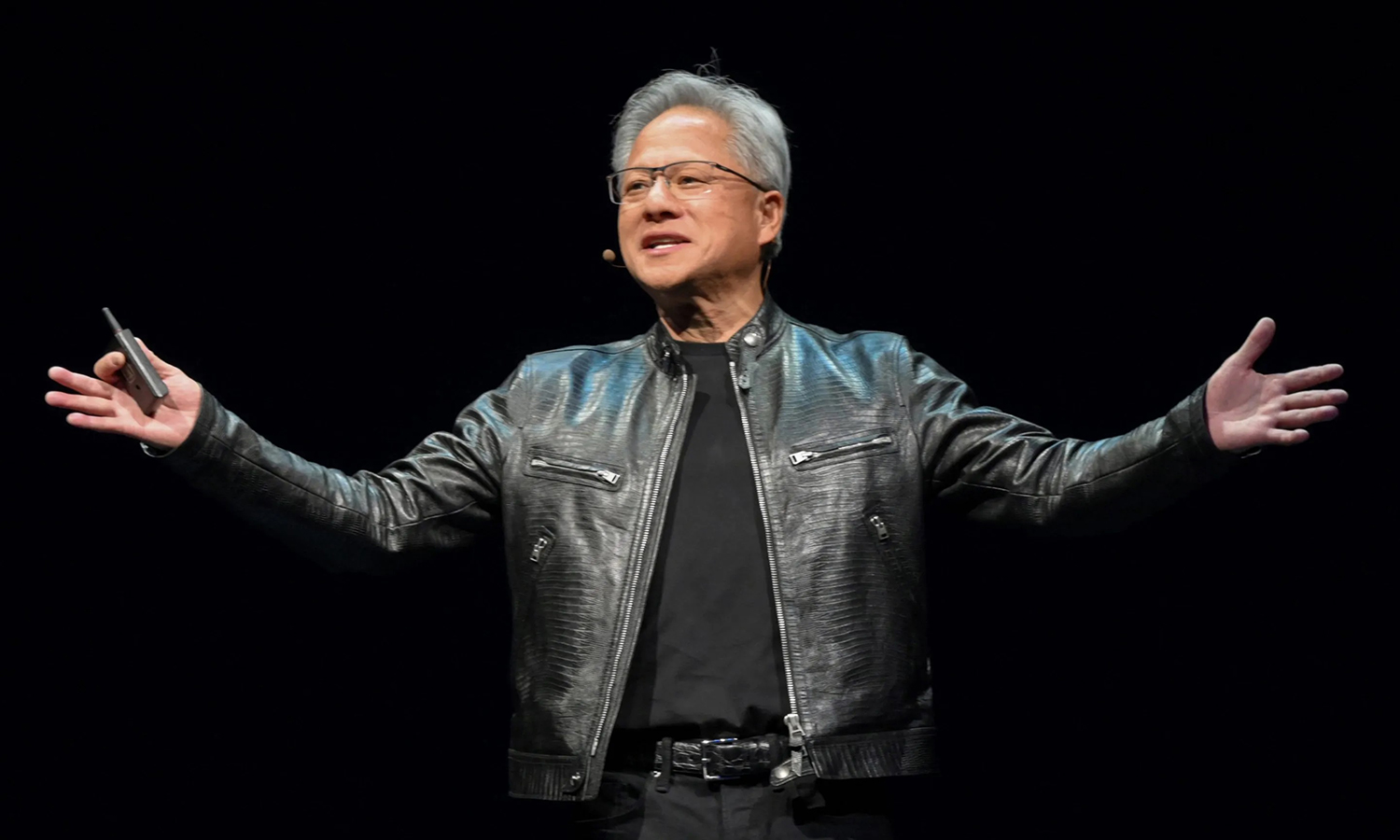
在备受期待的季度业绩报告中,人工智能芯片厂商英伟达(Nvidia)轻松超过了华尔街的销售预测,但由于市场对其期望过高,而且公司下一代芯片Blackwell的生产出现了一些小问题,影响了投资者的热情,导致公司股价下滑。
英伟达的市值超过3万亿美元,在全球排在第二位。周三,在业绩报告公布后的盘后交易中,英伟达股价下跌近7%。
此次股价波动使英伟达的市值缩水超过2,000亿美元,这凸显出这家硅谷芯片厂商和对人工智能商业潜力的高期望值,已经成为推动经济增长的重要力量。
英伟达表示,第二季度公司营收同比增长超过122%,总计达到300亿美元。根据彭博社汇总的预估数据,这远高于289亿美元的平均分析师预估。英伟达称,营收增长得益于其Hopper GPU芯片的销量增长。对英伟达芯片的强劲需求推动了公司的利润增长,使其毛利率达到75.1%,调整后每股收益为68美分(分析师预测的每股收益为65美分)。
英伟达表示,基于新Blackwell架构的芯片,将在今年第四季度开始出货,这符合先前公布的下半年出货的计划(尽管是在原计划日期范围的后半段)。英伟达还承认在生产过程中遇到了一些挑战,需要对“GPU掩膜”进行更改,以提高“生产良率”。
本月早些时候,科技资讯网站The Information报道称,Blackwell的设计缺陷可能导致出货时间推迟三个月甚至更长时间。英伟达CEO黄仁勋在周三的分析师电话会议上表示,生产问题已经解决。黄仁勋表示:“没有必要的功能修改。”
该公司表示,今年第四季度预计将“通过Blackwell实现数十亿美元的收入”。
黄仁勋在分析师电话会议上表示:“Blackwell将彻底改变整个行业,而且它的影响将持续到明年。”
人工智能支出放缓的风险
英伟达曾经是一家为视频游戏厂商提供图形加速器的设计公司。该公司的GPU成为驱动生成式人工智能服务的关键组件,如OpenAI的ChatGPT和谷歌(Google)的Gemini等。分析师表示,虽然面临芯片厂商AMD和Cerebras与Groq等初创公司的竞争,但英伟达当前控制了90%的人工智能芯片市场。
随着人工智能热的兴起,谷歌、Meta和亚马逊(Amazon)等互联网公司为了提供人工智能服务,在基础设施方面投入了数百亿美元,而英伟达成为最大的受益者之一。英伟达的市场主导地位使公司股价暴涨,今年已上涨超过一倍,目前它在标普500指数中的占比高达近7%。
尽管如此,在人工智能基础设施领域的巨额投资加剧了人们的持续担忧,即消费者和企业最终是否会购买足够多的人工智能服务,来证明这些投资是合理的。而英伟达的业务高度集中在Meta(Meta宣称今年计划囤积350,000枚英伟达GPU芯片)等几家大客户,因此人工智能基础设施支出减少,将对英伟达的业务产生严重影响。在周三公布业绩的同时发布的10-Q申报文件中,英伟达表示第二季度,四家客户(未具名)贡献了公司46%的营收。
在周三的电话会议上,当被问到这些风险时,CEO黄仁勋表示,对GPU芯片的需求在短期内不会消失。他表示,开发更先进、更强大的大语言模型的行业竞赛,需要更强大的人工智能芯片。而公司对于将人工智能服务整合到产品和业务当中的需求,意味着云服务提供商别无选择,只能继续提升人工智能能力。
黄仁勋表示:“看看全球的云服务提供商,他们几乎没有可用的GPU容量。”(财富中文网)
译者:刘进龙
审校:汪皓
在备受期待的季度业绩报告中,人工智能芯片厂商英伟达(Nvidia)轻松超过了华尔街的销售预测,但由于市场对其期望过高,而且公司下一代芯片Blackwell的生产出现了一些小问题,影响了投资者的热情,导致公司股价下滑。
英伟达的市值超过3万亿美元,在全球排在第二位。周三,在业绩报告公布后的盘后交易中,英伟达股价下跌近7%。
此次股价波动使英伟达的市值缩水超过2,000亿美元,这凸显出这家硅谷芯片厂商和对人工智能商业潜力的高期望值,已经成为推动经济增长的重要力量。
英伟达表示,第二季度公司营收同比增长超过122%,总计达到300亿美元。根据彭博社汇总的预估数据,这远高于289亿美元的平均分析师预估。英伟达称,营收增长得益于其Hopper GPU芯片的销量增长。对英伟达芯片的强劲需求推动了公司的利润增长,使其毛利率达到75.1%,调整后每股收益为68美分(分析师预测的每股收益为65美分)。
英伟达表示,基于新Blackwell架构的芯片,将在今年第四季度开始出货,这符合先前公布的下半年出货的计划(尽管是在原计划日期范围的后半段)。英伟达还承认在生产过程中遇到了一些挑战,需要对“GPU掩膜”进行更改,以提高“生产良率”。
本月早些时候,科技资讯网站The Information报道称,Blackwell的设计缺陷可能导致出货时间推迟三个月甚至更长时间。英伟达CEO黄仁勋在周三的分析师电话会议上表示,生产问题已经解决。黄仁勋表示:“没有必要的功能修改。”
该公司表示,今年第四季度预计将“通过Blackwell实现数十亿美元的收入”。
黄仁勋在分析师电话会议上表示:“Blackwell将彻底改变整个行业,而且它的影响将持续到明年。”
人工智能支出放缓的风险
英伟达曾经是一家为视频游戏厂商提供图形加速器的设计公司。该公司的GPU成为驱动生成式人工智能服务的关键组件,如OpenAI的ChatGPT和谷歌(Google)的Gemini等。分析师表示,虽然面临芯片厂商AMD和Cerebras与Groq等初创公司的竞争,但英伟达当前控制了90%的人工智能芯片市场。
随着人工智能热的兴起,谷歌、Meta和亚马逊(Amazon)等互联网公司为了提供人工智能服务,在基础设施方面投入了数百亿美元,而英伟达成为最大的受益者之一。英伟达的市场主导地位使公司股价暴涨,今年已上涨超过一倍,目前它在标普500指数中的占比高达近7%。
尽管如此,在人工智能基础设施领域的巨额投资加剧了人们的持续担忧,即消费者和企业最终是否会购买足够多的人工智能服务,来证明这些投资是合理的。而英伟达的业务高度集中在Meta(Meta宣称今年计划囤积350,000枚英伟达GPU芯片)等几家大客户,因此人工智能基础设施支出减少,将对英伟达的业务产生严重影响。在周三公布业绩的同时发布的10-Q申报文件中,英伟达表示第二季度,四家客户(未具名)贡献了公司46%的营收。
在周三的电话会议上,当被问到这些风险时,CEO黄仁勋表示,对GPU芯片的需求在短期内不会消失。他表示,开发更先进、更强大的大语言模型的行业竞赛,需要更强大的人工智能芯片。而公司对于将人工智能服务整合到产品和业务当中的需求,意味着云服务提供商别无选择,只能继续提升人工智能能力。
黄仁勋表示:“看看全球的云服务提供商,他们几乎没有可用的GPU容量。”(财富中文网)
译者:刘进龙
审校:汪皓
AI chipmaker Nvidia handily topped Wall Street sales targets in its highly anticipated quarterly earnings report — but the combination of sky high expectations and revelations of a minor production snag involving the company’s next-generation Blackwell chips derailed investor enthusiasm and sent shares sliding.
Shares of Nvidia, the world’s second most valuable public company with a market cap that has exceeded $3 trillion, were down nearly 7% at in after hours trading on Wednesday following the report.
The stock move, which wiped out more than $200 billion in market value, underscored the extent to which the Silicon Valley chipmaker, and red-hot expectations around the business potential of AI, have become a driving economic force.
Nvidia said revenue in the second quarter increased by more than 122% year-over-year, totaling $30 billion. That was well above the average analyst estimate of $28.9 billion, according to estimates compiled by Bloomberg. The results were driven by sales of Nvidia’s Hopper GPU, the company said. The strong demand for Nvidia’s chips boosted the bottom line, with the chipmaker delivering gross profit margins of 75.1% and adjusted earnings per share of 68 cents (analysts were expecting EPS of 65 cents).
Chips based on the new Blackwell architecture are slated to ship to customers in the fourth quarter of the year, Nvidia said, in line with previously announced plans (albeit at the back end of the date range) to begin shipments in the second half of the year. But the company also acknowledged production challenges that it said had required a change to the “GPU mask to improve production yield.”
Earlier this month, tech news site The Information reported that a design flaw with Blackwell would delay shipments by three months or more. Nvidia CEO Jensen Huang described the production problem as resolved on Wednesday, during a conference call with analysts. “There were no functional changes necessary,” Huang said.
The company said it expects to ship “several billion dollars in Blackwell revenue” in the fourth quarter of the year.
“Blackwell is going to be a complete game changer for the industry. And Blackwell is going to carry into the following year,” Huang told analysts on the call.
The risk of a slowdown in AI spending
Once a designer of graphics accelerators for video gamers, Nvidia has turned its GPUs into vital components for powering generative AI services like OpenAI’s ChatGPT and Google’s Gemini. While Nvidia faces competition from rival chipmaker AMD and startups including Cerebras and Groq, the company currently controls 90% of the market for AI chips, according to analysts.
As such, Nvidia has been one of the biggest beneficiaries of the AI craze, as internet companies like Google, Meta, and Amazon spend tens of billions of dollars on the infrastructure to provide AI services. Nvidia’s dominance has fueled a massive rally in the company’s stock, which has more than doubled this year and now represents nearly 7% of the S&P 500.
Still, the massive spending on AI infrastructure has fueled persistent worries about whether consumers and businesses will ultimately purchase enough AI services to justify the investments. And with Nvidia’s business so concentrated among several large customers like Meta (which has boasted of plans to amass a stockpile of 350,000 Nvidia GPUs this year), a pullback in AI infrastructure spending could have a big impact on Nvidia’s business. In its 10-Q filling released along with its results on Wednesday, Nvidia reported that four unnamed customers accounted for 46% of total revenue in the second quarter.
Asked about these risks on the conference call Wednesday, CEO Huang said the need for GPU chips will not go away anytime soon. The industry race to create more advanced and powerful large language models requires ever more powerful AI chips, he said. And the demand among companies to incorporate AI services into their products and operations means cloud providers have no choice but to keep building out AI capabilities.
“If you just look at the world’s cloud service providers, the amount of GPU capacity they have available, it’s basically none,” Huang said.






